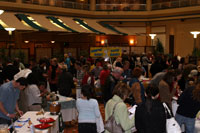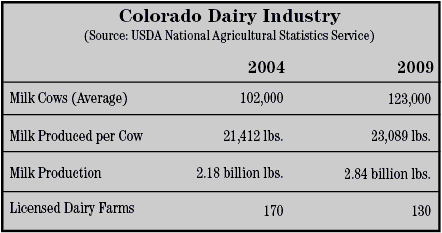 |
|||


|
 |


|
|
State of the Industry
Colorado dairy sees potential for growth as demand climbs
Editor’s note: As part of our “State of the Industry” series we take a look at the cheese and dairy industry across the United States. Each month we examine a different state or region, looking at key facts and evaluating areas of growth, challenges and recent innovations. This month we are pleased to introduce our latest state — Colorado.
By Rena Archwamety
MADISON, Wis. — Colorado’s Front Range, the north-south expanse that stretches east of the Rocky Mountain foothills, traditionally has been home to most of the state’s population as well as the majority of the state’s dairy industry.
 |
| CHEESE FAIR — The first annual Colorado Cheese Festival was held Nov. 14, 2009, and featured seven Colorado cheesemakers as well as others from Washington, Utah, Wisconsin, California, Minnesota, Vermont and Georgia. The event drew more than 600 participants and included more than 100 cheeses. The 2010 Colorado Cheese Festival is scheduled for Nov. 6 and 7. |
“It’s a great livestock area, the front range,” says Bill Wailes, head of animal sciences, Colorado State University. “We’re semi-arid, getting an average of 12 inches of moisture a year. It’s an excellent area for alfalfa, hay and corn silage. A lot of dairy farmers grow their own forages.”
The climate and forages help dairy herds to be productive. And while the high altitude can present some challenges, currently Colorado ranks third in the United States for milk production per cow, achieving an average of more than 23,000 pounds in 2009.
Colorado’s dairy industry has grown over the past few decades, and now it is the 15th largest dairy state. Weld County, home to 70 percent of Colorado’s dairy farms, is ranked the 17th largest dairy county in the nation and around sixth or seventh for agricultural receipts.
Aside from three dairy farms owned by Aurora Organic Dairy, Wailes says he would classify all of Colorado’s dairies, which range from very large to small with an average of approximately 650-700 cows, as “family farms.”
Like many states with growing populations, Colorado’s dairy producers have found the expanding metro areas good for demand but sometimes a challenge when expanding their own farms. Many of the dairies built in the past 5-10 years have opted to locate further east in the state.

“A lot of dairies have seen some urban encroachment,” says Ivan Steinke, director of quality resources, Colorado Livestock Association. “I believe the larger, more progressive dairies that have planned within themselves to expand and grow, that those growth plans may not be included in the Front Range. I think there will be a marketplace and value for Front Range dairy, but I don’t know at what size and scale that will be economical or practical.”
Steinke says Colorado environmental regulations are fairly friendly to all livestock producers. One challenge the industry faces is concern over increasing nitrogen deposits found in Rocky Mountain National Park. However, the Colorado Livestock Association has worked with Colorado State University researchers as well as state public health and environmental divisions to better pinpoint the sources of the nitrogen deposits (some of which are from out of state), and is working with dairy and other livestock producers to develop management practices to decrease the amount of nitrogen going to the park.
“We strive to keep the issues to a point so that we can handle them within those divisions and don’t need to move to a legislative fix,” Steinke says. “As the population grows, we have lost more rural legislators. There is more of a burden on us to relay the principles of livestock production in Colorado.”
• Demand for dairy
Colorado is the third-fastest growing state in the nation, with a population that rose nearly 15 percent from 2000-2008. According to the U.S. Census Bureau, the population in the Front Range Urban Corridor, which includes population centers such as Denver, Boulder and Colorado Springs, increased more than 15 percent in this period. Greeley, the Weld County seat, was up 38 percent to a quarter-million people. Average U.S. population growth for this period is around 8 percent.
“What does that mean for dairy farm families? It means there’s a lot of families to feed in Colorado,” says Cindy Haren, CEO of Western Dairy Association, the dairy checkoff organization that includes Colorado, Wyoming and Montana. “Our dairy producers are really poised to provide fresh products to meet the growing demand from consumers.”
Colorado is a milk deficit state, producing 565 pounds of milk per capita, which is under the national consumption average of 618 pounds per capita, Wailes says. About half of the state’s milk goes toward fluid production and the other half goes toward cheese.
Leprino Foods Co. is the major cheese processor in Colorado, with its headquarters in Denver and a Fort Morgan, Colo., plant which has the capacity to process 2.5 million pounds of milk per day and employs 270 people. Leprino also is breaking ground this spring on a new plant in Greeley, Colo., that is expected to have a final capacity to process 6.5 million pounds of milk a day and employ more than 500 people.
The quality and availability of Colorado’s milk supply was the principal driving factor for Leprino in choosing Greeley as the site for its new plant, according to Mike Reidy, senior vice president of procurement, logistics and business development, Leprino Foods.
“The reasons we’re in Colorado, both in Fort Morgan and Greeley, are the quality of the milk shed here in northeastern Colorado, as well as the quality and availability of raw water, access to labor, and viable solutions for handling wastewater,” Reidy says, adding that the state is supportive of agriculture in general, and the local communities have been extremely supportive of Leprino Foods.
Wailes says the new Leprino plant in Greeley in return will help boost demand for milk and help grow the state’s dairy industry.
“With Leprino coming in, it will increase the capacity for the manufacture of milk,” Wailes says. “Once Leprino builds, we will be growing our dairy population over the next couple of years to help meet the needs of the Leprino plant.”
Dean Foods is the largest fluid milk processor in Colorado, and its WhiteWave-Morningstar division is headquartered in Broomfield, Colo. Other major milk processors in the state include Kroger, Sinton and Safeway.
Colorado also is home to Aurora Organic Dairy, a major supplier of many private-label and store-brand organic milk and butter products. Aurora’s headquarters are in Boulder, Colo., and its processing facility is in Platteville, Colo. The company’s three Colorado dairy farms, with a combined total of around 8,000 cows, produce milk for approximately 40 percent of Aurora’s total production.
“Colorado provides an ideal location for our operations, with quality farmer-partners nearby, easy shipping access to our customers and a temperate climate that allows us to keep the cows outside year-round,” says Sonja Tuitele, vice president of communications, Aurora Organic Dairy.
• Specialty cheeses
Colorado is not well-known for artisan cheeses, but it does have a handful of successful smaller cheesemakers that sell goat’s, sheep’s and cow’s milk cheeses at local specialty stores and some nationwide.
Haystack Mountain Goat Dairy in Longmont, Colo., has received national and international acclaim for its cheeses. Haystack Camembert won a gold medal at the World Cheese Awards held last October in the Canary Islands. Last summer Haystack Mountain Goat Dairy received first place awards for its Feta and Haystack Peak and third-place awards for its Red Cloud and Dill and Garlic Chevre log at the American Cheese Society (ACS) contest.
MouCo Cheese Co., Fort Collins, Colo., also has found success with its Camembert and ColoRouge, which are sold nationwide and served at several high-end restaurants. MouCo ColoRouge received a second-place award and MouCo Camembert received a third-place award at the 2009 ACS contest.
Last November Jackie Rebideau, owner of Fromage to Yours, a Denver-area shop that specializes American specialty cheeses, launched the first annual Colorado Cheese Festival. The event, held at the Embassy Suites Denver Tech Center, featured seven Colorado cheesemakers as well as cheesemakers from other states and food, wine and beer vendors. Rebideau is planning to hold the 2010 Colorado Cheese Festival Nov. 6 and 7.
“I was looking at the kinds of cheese festivals going on in Seattle, Oregon and California, and the new ones in Vermont and Wisconsin, and thought ‘Why not here in Colorado?’” says Rebideau, who originally is from Vermont.
The 2009 festival drew more than 600 attendees and featured more than 100 cheeses, a Mozzarella-making demonstration, a grilled cheese challenge between chefs and educational sessions.
cheeses, a Mozzarella-making demonstration, a grilled cheese challenge between chefs and educational sessions.
Rebideau says she has seen increasing interest from Coloradoans in local specialty cheeses.
“The demand definitely is going up,” she says. “People are so patriotic now, looking to support the American cheese industry. When they see Colorado, they actually are drawn to it. They say, ‘I had no idea we made cheese in Colorado!’”
• Bright future
Colorado dairy industry groups and experts predict continued growth due to the state’s innovative producers and increasing opportunity.
“Colorado is home to some of the most innovative and dedicated producers. That for me spells out opportunity,” Haren says, pointing as an example to the work Colorado State University does with producers to develop better farm practices, nutrition and science.
“I do think we’re going to grow to meet the demands of consumers,” Haren adds. “We’re not going to be as large an industry as in California and some other states — we will be limited by natural resources like food and water — but it will grow to a certain extent.”
Wailes also says the dairy farmers in Colorado are very good and a fun group to work with. He sees growth once they can overcome the low prices that have been challenging the dairy industry over the past year.
“I think there’s a very good future for our dairy industry, they just need to get a break-even price this year,” Wailes says. “In 10 years if Colorado will get growth, I believe we will be in the top 10 dairy states in the U.S.”
CMN
| CMN article search |
|
|
© 2025 Cheese Market News • Quarne Publishing, LLC • Legal Information • Online Privacy Policy • Terms and Conditions
Cheese Market News • Business/Advertising Office: P.O. Box 628254 • Middleton, WI 53562 • 608/831-6002
Cheese Market News • Editorial Office: 5315 Wall Street, Suite 100 • Madison, WI 53718 • 608/288-9090